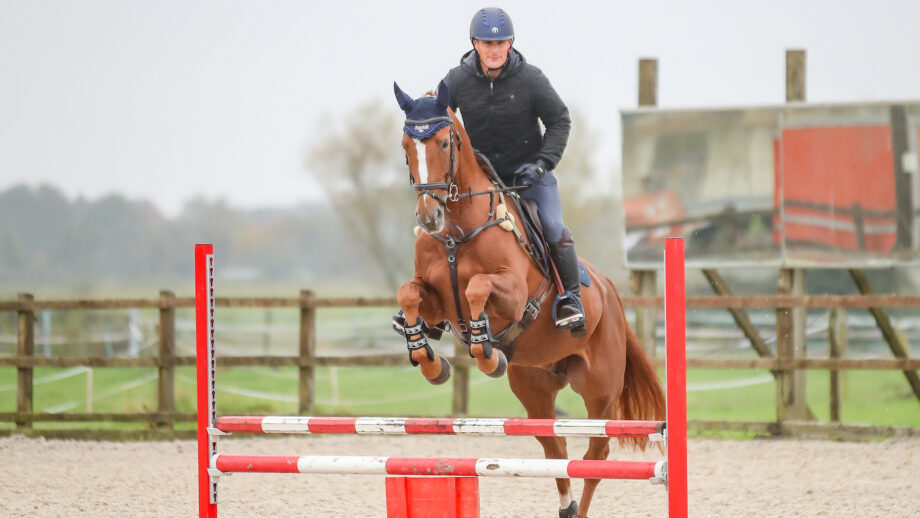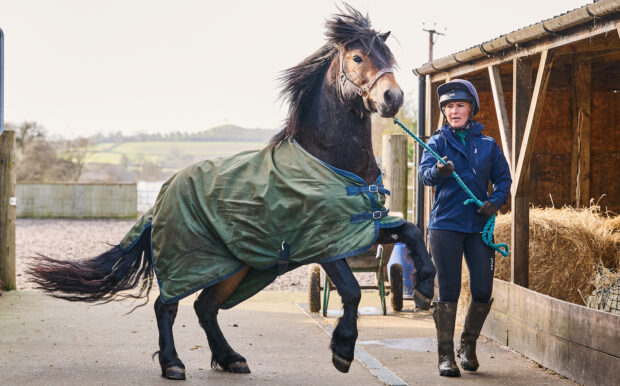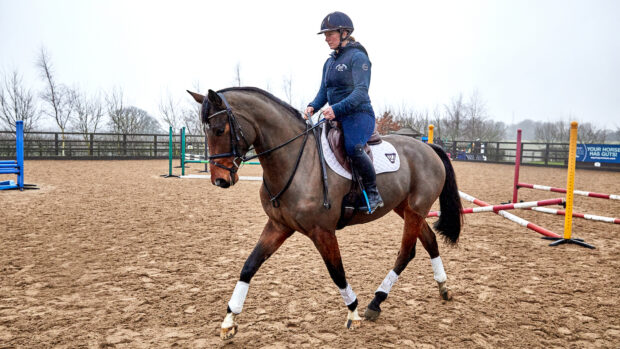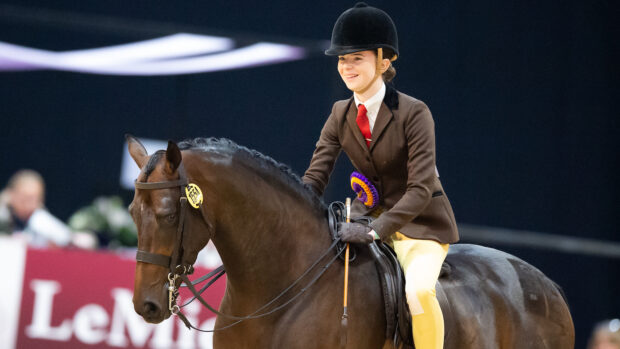“For me, in jumping, straightness is the key to everything,” says Alex Bragg, outlining his plan for this training session. “Without straightness, the horse will deviate over the jumps. This builds, and causes no end of problems, so you’re aiming to ride a course as a succession of straight lines.”
Teaching riders to be straight isn’t about fixating on the minutiae – giving them a broader objective is far more effective.
“Telling a rider they need a bit more inside leg here or outside rein there – it’s just too much to focus on,” he says. “When straightness is the most important thing, all you’ve got to think is about riding straight and your body reacts. If the horse doesn’t want to be on a straight line, you learn to apply the aids required to keep them there.”
Alex is riding a novice mare, Arva, for this training session. Initially, he works her in around a grid of fences – a bounce and two strides to an oxer – with two parallel uprights flanking the approach.
Alex Bragg training exercise: square turns and straightness
Working on: developing rider intuition and teaching the horse to follow guidance, and hone and expand jumping technique.
Level: Alex Bragg uses this training set-up for horses at every level: “More experienced horses might be able to go straight in, but with a younger horse we need to build up to it step-by-step.”
Warm-up
For Alex, the warm-up holds two objectives: get the horse aware of your aids and warm up the muscles.
“You’re always setting up for what you want to achieve in the session,” he adds.
Alex begins by performing square turns in canter, setting them up with leg-yield.
“The leg-yield helps with suppleness, but it also switches Arva on to the aids,” he says. “I can use this to make minor adjustments with my leg, always with the understanding that she’s moving away from the leg, not falling away.
“The goal is always to return to a place of straightness,” he continues. “I must finish every movement straight, or she won’t understand there’s been a correction and that running left or right is not accepted.”

Warming up in canter before starting the exercise. Credit Elli Birch
Next, Alex moves Arva on and back through canter gears “to get the back and hocks operating”. Again, straightness underpins his success.
“If she goes crooked, she won’t be able to use her back – you lose the gear through being crooked.”
Level one: just the turn
Looking at the exercise – which asks the horse and rider to navigate a 90º turn to one of the parallel uprights, change direction in the air and meet the grid (see diagram) – the twin tests of straightness and producing fence-appropriate technique are apparent. Watching Alex Bragg training through it reveals the vast web of benefits this five-fence formation can bring about.
The first is a lesson in concentration. Alex begins on the right rein to turn from the track to one of the two isolated uprights – but Arva doesn’t lock on to the fence.
“You can see how she’s struggling to be straight because she’s focusing elsewhere,” says Alex, gesturing to the arena’s other occupants – more fences, a photographer and two waggy yet well-behaved labradors. “This is important for me in a competition context: I need to fix this before I go bigger.”
On the second approach, the mare jumps cleanly and makes a neat left turn on landing.

A clean jump followed by a neat left turn. Credit: Elli Birch
“What I really like is that she’s not sliding over the jump,” comments Alex. “She’s pushing through her shoulders and her whole body is landing in great balance on the other side.”
Level two: the grid
The first bounce element is switched out for a pole and the fences are kept small while the horse gets her bearings. Alex performs a square turn and rides between the parallel uprights to the bounce.

The exercise begins with a pole on the ground before being built up to a full bounce. Credit: Elli Birch
“The tighter the turn, the taller your body. That way, you stay off the shoulder, in good balance and the canter remains uphill.”
Watching Alex approach and ride through the grid, his hand is noticeably soft and his seat has a neutral quality, although he remains in perfect balance throughout.
“I want to allow Arva to learn,” he explains. “My hands are soft and my body is passive because I want her to find the answer herself. I could use my position to make things clearer, but if she can do it without me, even better.”
Level three: all together
Alex turns right to the opening upright – but Arva comes in boldly and overshoots the line to the bounce.
“She’s a baby horse who’s just done cross-country, so she’s keen and wants to take on the contact,” says Alex. “But she doesn’t know where she’s going so next time, she’ll hopefully yield to the contact.”
This time, when Alex opens his right hand and applies his left leg over the fence, Arva turns squarely and smoothly to the grid on an easy four. Alex’s soft hand invites her to focus on her feet through the bounce and use her shoulder over the oxer.
Next, it’s time to put the fences up. With a bigger upright to contend with, Arva opens her stride and lands a little out of balance – Alex adjusts for five strides on the turn instead of four.

The fences can be raised as appropriate for the horse’s experience. Credit: Elli Birch
“The bigger the fence the more momentum you carry, and the trickier the turn. They have to be able to hold their balance after a big jump to turn for the bounce and exit with enough power to jump the big fence after that. This is really developing the half-halt and adjustability without losing power and forwardness.”
Riders need to be careful not to take too much of a check.
“It’s really important to be forward to the bounce, because the horse needs to push, and needs that energy to deliver another push in the middle of the bounce. This will also build core strength to create a nice shape.”
Stepping up
While the bounce remains small, the elements in and out of the exercise can be as big as you like.
“Just remember that the bigger they are, the more energy in the jump, the harder the turn,” says Alex.
The fences can be made into skinnies for a tougher test of straightness.
“Now, this is like doing a difficult combination at a five-star,” he remarks. “Same questions, just smaller fences.”
“In training, you’re giving the horse versatility, a toolbox to choose from and make adjustments.”
You may also enjoy reading…

Horseball, water treadmills and a French connection – nine things you didn’t know about Alex Bragg

*Exclusive* Sharp and snappy: Gemma Stevens’ gridwork exercise that will teach your horse to be both careful and bold

*Exclusive* Improve your horse’s footwork while jumping and have fun with Gemma Stevens’ gridwork exercise

*Exclusive* Improve your horse’s rideability and straightness with Harry Meade’s three-fence jumping exercise

*Exclusive* ‘Aim to do this straightforward exercise to score 10 out of 10’: how Harry Meade uses polework to improve suppleness





